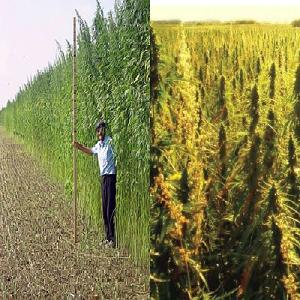 The Hemp Industries Association (HIA), a non-profit trade association consisting of hundreds of hemp businesses, has released final estimates of the size of the 2015 U.S. retail market for hemp products. Data from market research supports an estimate of total retail sales of hemp food, supplements and body care products in the United States at $283 million. Sales of popular hemp items like non-dairy milk, shelled seed, soaps and lotions have continued to increase, complemented by successful hemp cultivation pilot programs in several states, and increasing grassroots pressure to allow hemp to be grown domestically on a commercial scale once again for U.S. processors and manufacturers. The HIA has also reviewed sales of clothing, auto parts, building materials and various other products, and estimates the total retail value of hemp products sold in the U.S. in 2015 to be at least $573 million.
The Hemp Industries Association (HIA), a non-profit trade association consisting of hundreds of hemp businesses, has released final estimates of the size of the 2015 U.S. retail market for hemp products. Data from market research supports an estimate of total retail sales of hemp food, supplements and body care products in the United States at $283 million. Sales of popular hemp items like non-dairy milk, shelled seed, soaps and lotions have continued to increase, complemented by successful hemp cultivation pilot programs in several states, and increasing grassroots pressure to allow hemp to be grown domestically on a commercial scale once again for U.S. processors and manufacturers. The HIA has also reviewed sales of clothing, auto parts, building materials and various other products, and estimates the total retail value of hemp products sold in the U.S. in 2015 to be at least $573 million.
Of this $573 million hemp market, the HIA estimates that hemp foods constituted 16% ($89.5 million); personal care products constituted 26% ($147 million); textiles constituted 17% ($95 million); supplements constituted 8% ($47.1 million); hemp derived cannabidiol or CBD products constituted 11% ($65 million); industrial applications such as car parts constituted 20% ($116.2 million); and other consumer products such as paper and construction materials accounted for the remaining 2% of the market.
The sales data on hemp foods and body care, collected by market research firm SPINS, was obtained from natural and conventional retailers, excluding Whole Foods Market, Costco and certain other key establishments, who do not provide sales data — and thus it significantly underestimates actual sales. According to the SPINS data, combined U.S. hemp food and body care sales grew in the sampled stores by 10.4% or $9,269,376, over the previous year ending December 31, 2015 to a total of just over $89,183,460. According to SPINS figures, sales in conventional retailers grew by 11.25% in 2015, while sales in natural retailers grew by 9.43%. Indeed, the combined growth of hemp retail sales in the U.S. continues steadily: annual natural and conventional market percent growth has progressed from 7.3% (2011), to 16.5% (2012), to 24% (2013), 21.2% (2014), to 10.4% in 2015.
As the hemp industry in the U.S. continues to develop, more detailed data has become available through various reporting channels. Previously, the HIA had calculated the size and growth of the hemp market in the U.S. based on approximations of sales in the categories of textiles, auto parts, building materials and other products, in addition to known data on the sales of hemp foods and body care. Now that more specific information is available, the HIA has updated its formula to reflect a more conservative, but more accurate estimate for the hemp market for 2015. Hence, the shift from the 2014 figure of $620 million to the 2015 estimate of $573 million does not demonstrate a decrease in the actual hemp market; rather it reflects a more precise means of estimating the actual industry for 2015. The data for 2015 that assert 10.4% growth from 2014 to 2015 demonstrate a strong rate of market increase for hemp products in food and body care.
“The HIA estimates the total retail value of all hemp products sold in the U.S. to be at least $573 million for 2015,” says Eric Steenstra, Executive Director of the HIA. “To date, 28 states have passed legislation that allows hemp farming per provisions set forth in the 2014 Farm Bill, and new businesses representing all industrial fields from foods to car manufacturing are looking to American farmers to meet the growing demand for hemp. Entrepreneurs, manufacturers, farmers, consumers are all on board to expand the hemp market. We need Congress to pass federal legislation to allow commercial hemp farming nationally, for this ripe industry to finally be able to bloom,” continues Steenstra.
The HIA has calculated that approximately 3,997 acres of hemp crops were planted in 7 states during 2015 in the U.S. This hemp cultivation is legal in 28 states, which have lifted restrictions on hemp farming and may license farmers to grow hemp in accordance with Sec. 7606 of the Farm Bill, the Legitimacy of Industrial Hemp Research amendment. Read the full text of Sec. 7606 on the Vote Hemp website: https://www.votehemp.com/PDF/Pages_from_farm0127.pdf.
In January of 2015, The Industrial Hemp Farming Act was introduced in both the House and Senate, H.R. 525 and S. 134 respectively. If passed, the legislation would remove all federal restrictions on the cultivation of industrial hemp, and remove its classification as a Schedule 1 controlled substance. Currently, 28 states may grow hemp per Sec. 7606 of the Farm Bill, including California, Colorado, Connecticut, Delaware, Hawaii, Illinois, Indiana, Kentucky, Maine, Maryland, Michigan, Minnesota, Missouri, Montana, Nebraska, Nevada, New York, North Carolina, North Dakota, Oregon, Pennsylvania, South Carolina, Tennessee, Utah, Vermont, Washington, West Virginia and Virginia.
Source: The Hemp Industries Association (HIA) represents the interests of the hemp industry and encourages the research and development of new hemp products. More information about hemp’s many uses and hemp advocacy may be found at www.TheHIA.org and www.VoteHemp.com.








